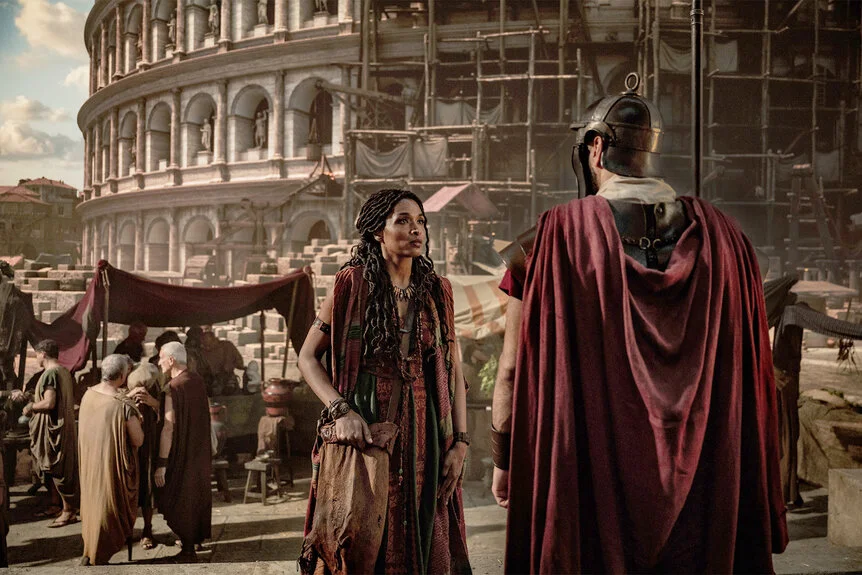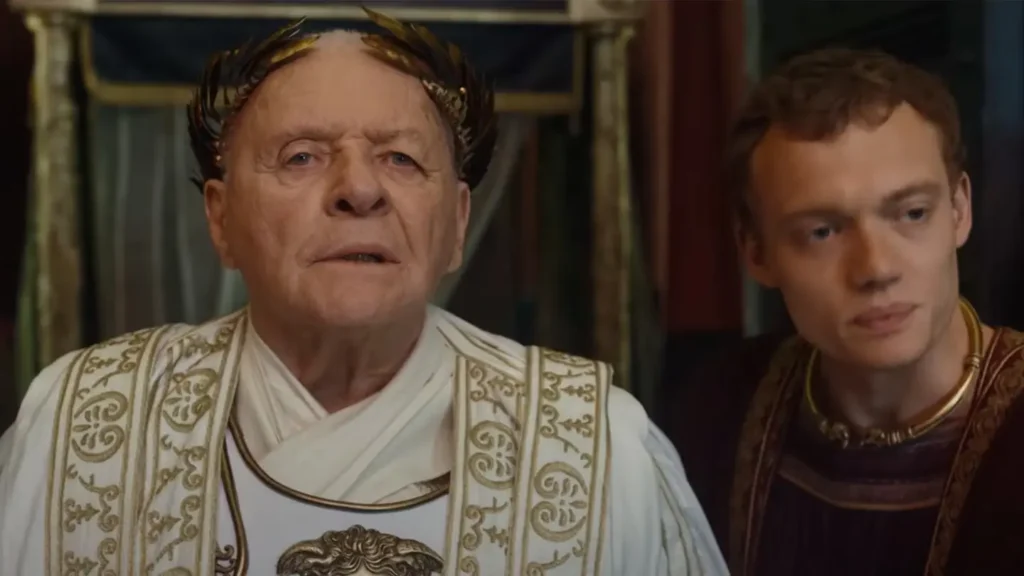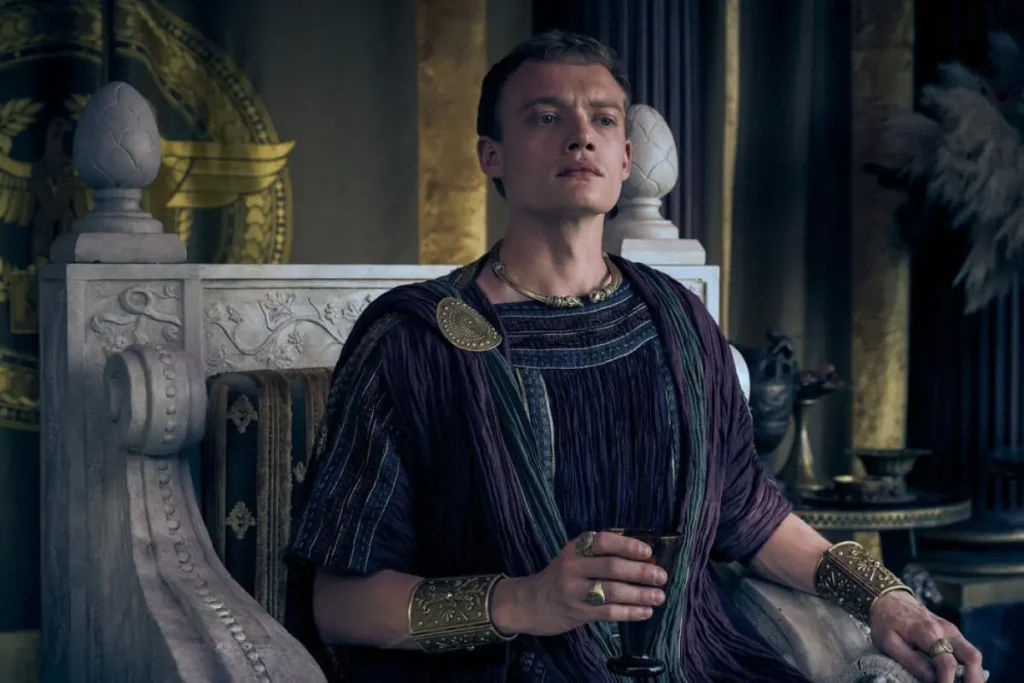A Deep Dive into Those About to Die: A Masterful Blend of History, Drama, and Human Emotion
Table of Contents
Opening Statement:
In a television landscape crowded with period dramas, Those About to Die stands out as a masterclass in storytelling, offering a gritty and emotionally resonant portrayal of life in the Roman Empire. This series isn’t just about gladiators fighting in the arena; it’s about the human condition, exploring themes of power, freedom, and survival against the backdrop of one of history’s most fascinating eras.
General Overview:
Set during the height of the Roman Empire, Those About to Die brings to life the brutal world of gladiatorial combat, political intrigue, and the daily struggles of those living under Roman rule. The drama follows multiple characters, each with their own story to tell, weaving their lives together in a narrative that is as compelling as it is heartbreaking.
Story and Plot Overview
Main Plot
The story begins with Quintus Valerius, a decorated Roman soldier who returns to Rome after years on the battlefield, only to find himself betrayed by those he trusted most. Falsely accused of treason, Quintus is stripped of his status and sentenced to the arena, where he must fight as a gladiator to survive. As he battles for his life, Quintus uncovers a conspiracy that goes to the very heart of the Roman Senate, involving some of the most powerful men in the empire.
The drama also follows the life of Lucia, a young woman who has been a slave all her life. Intelligent and resourceful, Lucia becomes entangled in the political machinations of her master, Senator Gaius Cassius. Through her eyes, we see the cruelty and corruption of the Roman elite, as well as the strength and resilience required to survive in such a world.
Another key storyline focuses on Marcus, a young gladiator with a dark and mysterious past. His journey from an obscure provincial outcast to a revered champion in the Colosseum serves as a parallel to the rise and fall of the Roman Empire itself. Marcus’s story is one of vengeance, redemption, and the search for identity in a world that is often cruel and unforgiving.

Subplots and Interweaving Narratives
The series excels in its ability to interweave these narratives, creating a complex tapestry of stories that reflect the interconnected nature of life in ancient Rome. Each character’s journey is influenced by the others, with their fates often colliding in unexpected and dramatic ways. The subplots – whether they involve the political intrigues of the Senate, the personal vendettas of the gladiators, or the survival strategies of the slaves – all contribute to a rich and multifaceted narrative.
Key Episodes
Episode 1: “The Fall of a Hero”: The series opens with Quintus’s fall from grace, setting the stage for his journey of survival and revenge. This episode introduces the key players in the drama and establishes the high stakes that will drive the narrative.
Episode 4: “Blood and Sand”: A pivotal episode where Quintus faces his first major battle in the arena. The fight scenes are intense and brutal, showcasing the life-or-death nature of gladiatorial combat.
Episode 7: “The Viper’s Nest”: This episode delves into the political intrigues of Rome, focusing on Gaius Cassius and his ruthless strategies to maintain power. Lucia’s role as a spy is also highlighted, adding tension and suspense.
Episode 10: “The Turning Point”: In the season finale, the various plotlines converge, leading to a dramatic and emotionally charged conclusion. Quintus makes a crucial decision that will determine not only his fate but also the future of Rome itself.
Character Analysis
Quintus Valerius
Quintus is the quintessential tragic hero. His journey from a respected soldier to a condemned gladiator is marked by profound personal loss and the shattering of his ideals. Initially driven by a desire for revenge against those who betrayed him, Quintus gradually evolves into a more complex character, embodying the struggle between vengeance and justice. His transformation is one of the most compelling aspects of the series, as he learns to navigate the brutal world of the arena while holding onto his humanity.
Lucia
Lucia’s character is a study in resilience and adaptability. Born into slavery, she quickly learns to navigate the dangerous waters of Roman politics, using her wit and intelligence to survive. Her relationship with Gaius Cassius is particularly intriguing, as it blurs the lines between power and vulnerability, control and submission. Lucia’s story highlights the limited agency available to women in Roman society, yet she emerges as one of the most powerful characters in the series through her cunning and resourcefulness.
Gaius Cassius
As the primary antagonist, Gaius Cassius represents the corruption and moral decay at the heart of the Roman Empire. A senator with ambitions of absolute power, Gaius is ruthless in his pursuit of his goals, willing to betray anyone who stands in his way. Yet, his character is not a mere caricature of evil; he is a deeply complex figure whose actions are driven by a belief in the superiority of Rome and a desire to preserve its legacy at any cost.
Marcus
Marcus’s journey is one of the most emotionally resonant in the series. Haunted by his past and driven by a desire to prove himself, Marcus’s rise in the gladiatorial ranks is both a physical and psychological battle. His relationship with Quintus, initially one of rivalry, gradually develops into a deep bond of mutual respect and friendship. Marcus’s story is a powerful exploration of identity, redemption, and the search for meaning in a world defined by violence and oppression.
Supporting Characters
- Aurelia: Quintus’s wife, who represents the life he has lost and the future he still dreams of. Her absence is a constant reminder of what has been taken from him, driving much of his actions.
- Senator Lucius: A more moderate voice in the Senate, who represents the fading ideals of the Republic. His interactions with Gaius highlight the political tensions and moral compromises that define Roman governance.
- Felix: A fellow gladiator and mentor to Marcus, whose wisdom and experience offer a counterpoint to the younger man’s fiery ambition. Felix’s death in the arena is a turning point for Marcus, pushing him further along his path of vengeance.

Themes and Symbolism
Core Themes
- Power and Corruption: The series offers a searing critique of power and its corrupting influence. Whether it’s the senators in the Roman Senate or the gladiators in the arena, the pursuit of power inevitably leads to moral compromises and the erosion of personal integrity. The drama portrays how those who seek power, like Gaius Cassius, often lose their humanity in the process, while those who are victims of power, like Quintus and Lucia, must struggle to retain theirs.
- Freedom and Slavery: Freedom in Those About to Die is depicted as a relative concept, not just for the literal slaves like Lucia but also for the free men like Quintus who are imprisoned by their circumstances. The gladiators, although physically confined and bound by the chains of slavery, often exhibit a moral and psychological freedom that eludes their so-called masters. The series explores the irony of this condition, showing how even the most powerful figures in Rome are, in a sense, enslaved by their ambitions and fears.
- Survival and Identity: The theme of survival is central to the narrative, not just in the physical sense but also in the psychological and emotional realms. The characters are constantly fighting to survive in a world that is both brutal and indifferent. This struggle for survival is closely tied to the question of identity – who they are, who they were, and who they aspire to be. The gladiators, in particular, face an existential battle to retain their sense of self in a society that views them as mere tools for entertainment.
Symbolism
- The Arena: The Colosseum, the arena where gladiators fight to the death, is a powerful symbol in the series. It represents the heart of Rome – a place where power, violence, and spectacle converge. The arena is not just a physical space but a metaphorical one as well, symbolizing the ruthless competition and the survival of the fittest that define Roman society.
- Blood: Blood is a recurring motif in the series, symbolizing both life and death. In the arena, blood is spilled as a spectacle for the masses, a testament to the brutal nature of the games. But blood also represents the sacrifices made by the characters – the blood of the innocent, the blood of the guilty, and the blood that binds family and comrades together.
- Chains and Shackles: Chains are used throughout the series to symbolize both literal and figurative bondage. For the gladiators, the chains are a physical reminder of their enslavement, but they also symbolize the social and political constraints that bind the characters. Even the powerful senators, who wield significant influence, are depicted as being chained to their own ambitions, fears, and desires.
Cinematography, Visuals, and Production Design
Cinematography
The visual style of Those About to Die is one of its strongest assets. The cinematography is carefully crafted to evoke the grandeur and brutality of ancient Rome. Wide-angle shots of the Colosseum and the Roman Forum convey the scale and power of the empire, while intimate close-ups capture the emotional intensity of the characters’ struggles. The use of light and shadow is particularly effective, with scenes often bathed in the warm glow of Roman sunlight or the cold, harsh light of the arena.
Production Design
The production design is meticulous in its attention to detail, creating a world that feels both authentic and lived-in. The sets are richly detailed, from the opulence of the Senate chambers to the gritty, blood-stained sands of the arena. The contrast between the different environments – the luxury of the Roman elite versus the harshness of the gladiators’ quarters – underscores the social divisions that are central to the narrative.
Costume Design
Costume design plays a significant role in defining the characters and their social status. The gladiators’ armor, each piece unique and reflective of their personal histories, contrasts sharply with the togas and robes of the senators, symbolizing the divide between the ruling class and those they rule over. Lucia’s costumes evolve throughout the series, reflecting her journey from a slave to a woman of influence, with subtle changes in fabric, color, and style that mirror her inner transformation.
Special Effects and Action Sequences
The special effects in Those About to Die are used sparingly but effectively. The action sequences, particularly the gladiatorial combats, are choreographed with a focus on realism and impact. The fights are brutal and intense, with every clash of swords and every wound depicted in visceral detail. The use of practical effects, combined with subtle CGI enhancements, creates a seamless and immersive experience for the viewer.

Direction and Writing
Direction
Directed by [Director’s Name], Those About to Die is a triumph of both style and substance. The direction is assured and confident, with a clear vision that balances the demands of historical accuracy with the need for dramatic storytelling. The pacing is deliberate, allowing the narrative to unfold organically, with moments of high tension interspersed with quieter, character-driven scenes. The director’s ability to draw out nuanced performances from the cast, combined with a keen eye for visual composition, results in a series that is both visually stunning and emotionally resonant.
Writing
The writing in Those About to Die is one of its standout features. The dialogue is sharp and incisive, capturing the formal tone of the period while remaining accessible to modern audiences. The narrative structure is complex, with multiple plotlines that are intricately woven together, creating a rich and layered story. The writers have done an exceptional job of balancing historical facts with creative fiction, ensuring that the drama remains engaging while also being grounded in the reality of the time.
Narrative Techniques
The series employs a variety of narrative techniques to enhance the storytelling. Flashbacks are used effectively to reveal the characters’ backstories, providing context for their present actions and motivations. The use of parallel narratives, where the lives of the gladiators are juxtaposed with those of the Roman elite, serves to highlight the contrasts and similarities between different strata of society. The series also makes use of dramatic irony, where the audience is aware of information that the characters are not, creating tension and anticipation.
Soundtrack and Audio Design
Music Score
The soundtrack of Those About to Die is a masterful blend of traditional Roman music and original compositions, creating an auditory experience that is both immersive and evocative. The music plays a crucial role in setting the tone for the series, with grand orchestral pieces accompanying the epic battles and more intimate, haunting melodies underscoring the personal struggles of the characters. The use of traditional instruments, such as the lyre, cithara, and aulos, adds authenticity to the score, while the original compositions bring a modern sensibility to the ancient setting.
Sound Design
The sound design is equally impressive, with a meticulous attention to detail that enhances the viewer’s immersion in the world of ancient Rome. The clash of swords, the roar of the Colosseum crowd, the subtle sounds of the marketplace or the whispers in the Senate – all contribute to a rich and textured soundscape. The series also makes effective use of silence, particularly in moments of high tension, allowing the viewer to fully absorb the gravity of the situation.
Dialogues and Audio Mixing
The dialogue is crisp and clear, with each character’s voice reflecting their status, background, and personality. The audio mixing ensures that the dialogue remains intelligible even in the midst of chaotic battle scenes or crowded public spaces. The voices of the characters are complemented by the ambient sounds of their environment, creating a dynamic and immersive auditory experience.
Overall Impression
Final Thoughts
In conclusion, Those About to Die is a standout entry in the genre of historical drama. It offers a compelling and richly textured portrayal of life in the Roman Empire, brought to life through exceptional performances, meticulous production design, and a gripping narrative. The series succeeds not just as a piece of entertainment but also as a thoughtful exploration of power, identity, and survival in one of history’s most complex societies.
The show’s ability to balance action with deep character development, historical authenticity with engaging storytelling, makes it a must-watch for fans of the genre. Whether you’re drawn to the spectacle of gladiatorial combat, the intrigue of Roman politics, or the emotional journeys of its characters, Those About to Die delivers on all fronts. It’s a series that stays with you long after the credits roll, leaving you eager for the next chapter in this epic tale.
Rating
I would rate Those About to Die a solid 9 out of 10, for its exceptional storytelling, powerful performances, and its ability to immerse the viewer in the world of ancient Rome. The minor flaws, such as occasional pacing issues, are far outweighed by the series’ many strengths.
What did you think of Those About to Die? Share your thoughts and interpretations in the comments below. If you enjoyed this review, don’t forget to share it with your friends and fellow drama enthusiasts. And stay tuned for more in-depth reviews and analyses of your favorite shows!
Frequently Asked Questions About Those About to Die 2024
1. What is the historical accuracy of Those About to Die?
The series Those About to Die is grounded in a historical setting, focusing on the Roman Empire during its peak. While the show takes creative liberties for dramatic effect, many aspects, such as the depiction of gladiatorial combat, Roman politics, and social structures, are based on historical research. The production team consulted historians and experts to ensure the sets, costumes, and cultural practices were as authentic as possible, although some events and characters are fictionalized to enhance the storytelling.
2. Is Those About to Die suitable for all audiences?
Given its portrayal of violence, including gladiatorial combat, and mature themes such as political corruption, betrayal, and slavery, Those About to Die is recommended for mature audiences. The show contains graphic scenes that may not be suitable for younger viewers or those sensitive to violence. Viewer discretion is advised, and parents may want to preview the series before allowing younger audiences to watch.
3. How does Those About to Die compare to other historical dramas set in ancient Rome?
Compared to other historical dramas like Spartacus or Rome, Those About to Die offers a more nuanced exploration of the lives of gladiators and the political intrigue of the Roman Senate. While Spartacus is known for its action and stylized violence, Those About to Die focuses more on character development and the moral dilemmas faced by its protagonists. Rome provided a broad overview of Roman history, while Those About to Die zooms in on the gladiatorial aspect, offering a fresh perspective within the same historical context.
4. Are there real historical figures in Those About to Die?
While the main characters in Those About to Die, such as Quintus Valerius and Lucia, are fictional, they are inspired by real types of people who would have lived during the Roman Empire. The series also features characters based on or inspired by real historical figures, particularly within the Roman Senate and among the elite. The creators have taken care to blend fiction with historical references, making the series both educational and entertaining.
5. Will there be more seasons of Those About to Die?
As of now, there has been no official announcement regarding additional seasons of Those About to Die. The first season ends on a note that leaves room for further exploration of the characters’ stories and the historical period. Given the positive reception and the rich potential for more storytelling within the Roman Empire setting, fans are hopeful that the series will continue. Stay tuned for updates from the production team or the network regarding the future of the series.
